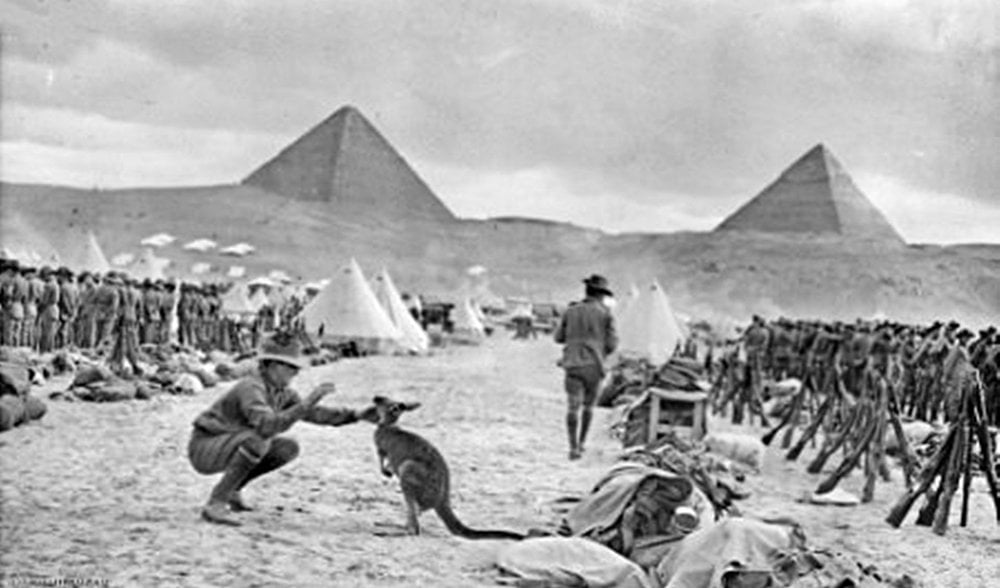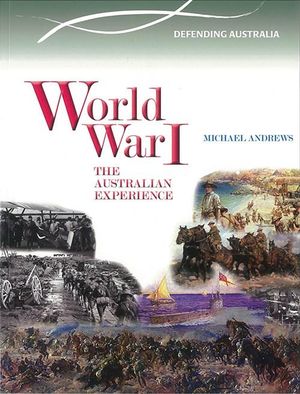



Source: Australian War Memorial
As news reached Australia about the rising tensions in Europe after the assassination of Archduke Franz Ferdinand, many Australians wondered if Australia--only 14 years old as a nation-- would be pulled into war alongside Great Britain. By August 2014 Australia would have its answer: we were at war. Read through the resources below to learn more about Australia entering the war and how we as a nation reacted to the news.
By mid-1914 Australians were aware through their newspapers of the rising tensions and dangers of war in Europe. The response to the outbreak of war was generally one of joint patriotic exuberance for the nation and for the British Empire. Read through this article to learn more.
On 6 August 1914 crowds gathered on street corners, engaged in animated discussions about Australia’s involvement in the international conflict that had begun only weeks earlier, when on 28 July 1914 Austria-Hungary declared war on Serbia. Later that night, Australia’s official involvement in the war was announced, and the raucous crowd outside The Argus turned boisterous. A mob of 3000 young men agitated in support of Britain. Amidst the riotous chaos, a police horse was stabbed and businesses were vandalised. Despite this rough turn, says Aaron Pegram, a historian at the Australian War Memorial, “When the news was received, going to war alongside Britain was universally considered to be the right thing to do. Both the government and the opposition agreed unanimously”. Read through this article to learn more about Australia's response to joining the war.
On 31 July 1914 in an election speech at Colac in Victoria, the Opposition Leader Andrew Fisher (ALP) famously declared that ‘should the worst happen, after everything has been done that honour will permit, Australians will stand beside the mother country to help and defend her to our last man and our last shilling’. This Research Paper considers the context of Fisher’s declaration by briefly outlining the steps leading to the outbreak of the war and the costs to Australia by the end of hostilities. It then examines two particular issues of relevance in the parliamentary environment: the extent of an independent Australian foreign policy and why Britain’s declaration of war was considered to automatically include Australia, and second, the role of the parliament in committing Australia to war.
Although the theatres of war were very distant from Australia, its membership of the British Empire ensured that there was strong (although not universal) public support for involvement in the war. In 1914, Australia's Prime Minister, Andrew Fisher, immediately promised Australian support for Britain 'to the last man and the last shilling'. Read through this fact sheet to learn more about Australia's involvement in the war.
In July 1914 the Australian Government and Australian people followed the news from Europe with growing anxiety. Would there be war? What would Australia's contribution be? Read through this article to learn more.
A lot of people think about Australia and the First World War in terms of Gallipoli, but Australia's first military engagement was just after the declaration of World War 1 which was 5th of August 1914. And that's when Britain declared war on Germany, and then Australia decided that they would declare war as well.
The British government really wanted the Australians to address the problem of German colonial occupation of New Guinea. They formed a couple of initial responses, and the first was the formation of the Australian Naval and Expeditionary Force, it was also known as the Tropical Force. And they left Sydney and headed up to New Guinea. The other initial response they had was to defend Australian territory. For many years Australia had a garrison that was stationed on Thursday Island. This was the first communication that Australia had from Britain asking for their help in the war. Read through this article to learn more.
The raising of the AIF and its despatch overseas was an enormous task that exceeded by several orders of magnitude any remotely comparable mobilisation of people and resources in Australia's short history. Read through this website to learn more and find links to more resources about Australia's deployment into World War I.
Australians read about the political assassination of Franz Ferdinand in the newspapers published at the end of June, 1914 and would continue to read about the existing tensions and series of events that ultimately led to the outbreak of war. After German troops entered Belgium on 4 August, the United Kingdom declared war on Germany.
Australia, a dominion of the British Empire, willingly joined the war to aid the mother country. Australia pledged an immediate force of 20,000 troops, with more to follow. Read through this website to learn more.
At the start of World War I, Australia was a nation of around four million people. This meant that there was a potential pool of around 820,000 men of ‘fighting age’ (between 19 and 38). Read through this article to learn more about Australia's enlistment and participation in WWI.
World War I broke out in 1914 but for some years before that the rapid rise of Germany, the increasing instability in Europe, and the likelihood that Australia would be expected to send assistance if Great Britain became involved in war had caused the Australian government to introduce compulsory military training and take other steps to ensure national preparedness. Read through this article to learn more.
During World War I, more than 416, 000 Australians enlisted in the Australian Imperial Force (AIF) for overseas service. The vast majority were men, but a small number were women who joined the Australian Army Nursing Service. What is important to remember is that the AIF was not the regular Australian army, but a force raised especially for overseas service for the duration of the war, and every man and woman in it was a volunteer. Of these volunteers, more than 331, 000 were actually sent overseas, where they served in Egypt, Gallipoli, the Middle East and predominantly on the Western Front in France and Belgium between April 1916 and November 1918. Enlistment for the force began all over Australia soon after the outbreak of war on 4 August 1914 and continued until the end of the conflict. Read through this chapter to learn about some of the reasons why so many Australians enlisted to fight in World War I.
When the United Kingdom (UK) declared war on Germany on 4 August 1914, nations in the British Empire followed willingly. Part of the Australia's response to war was to pledge an immediate force of 20,000 Australian troops, with more to follow. Read through this article to learn more about Australia's enlistment process and contribution to the war effort.
This website has a year by year breakdown of Australian enlistments in WWI.
After Australia joined the war effort it wasn't long until they engaged in their first action of World War One: capturing German New Guinea and dismantling the vital communication systems that supported German naval assets based in the Pacific. Read through this article to learn more.
It was a six-week journey by sea from Australia to Egypt for the First AIF contingent. Read through this article to learn more about the long journey to war.


This newspaper article talks about Australia's commitment to Britain and whether we should follow Britain into war.

This article is a great example of the nationalism that overtook Australia at the outbreak of war.

The cover of the Sydney Mail depicts the sentiment at the time - the British dominions supporting the 'Old Country' in the image of John Bull. Australia is seen as the young boy in the slouch hat.

An Act to enable Governor-General to make Regulations and Orders for the safety of the Commonwealth during the present state of war.


 Australia and the First World War, 1914-18
by
Australia and the First World War, 1914-18
by
 Australians at war : the illustrated history
by
Australians at war : the illustrated history
by
 Australians in the First World War
by
Australians in the First World War
by
 The broken years : Australian soldiers in the Great War
by
The broken years : Australian soldiers in the Great War
by
 World War I : the Australian experience
by
World War I : the Australian experience
by